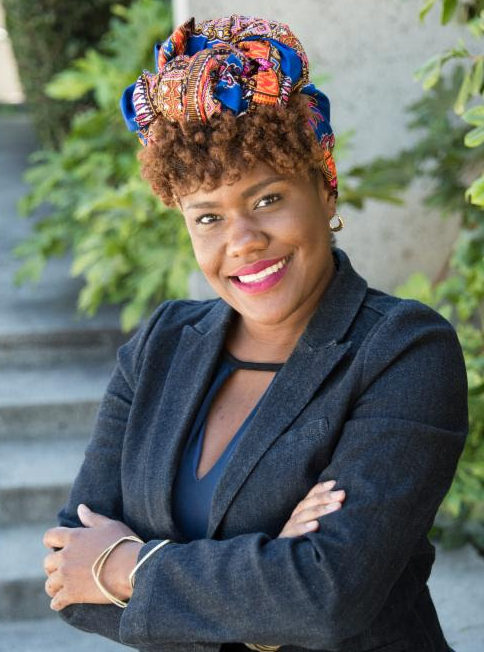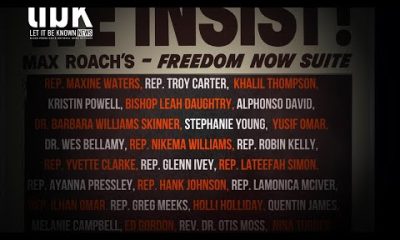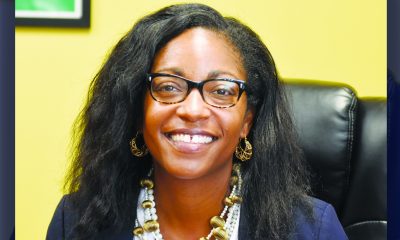Arts and Culture
Oakland Museum Appoints Anyka Barber as Director of Engagement

| The Oakland Museum of California (OMCA) has announced Anyka Barber as its new Director of Engagement.
Barber brings more than 10 years of extensive experience in arts administration, cultural programming, and business development to this leadership role at OMCA. Her includes seven years of experience as Founder and Director of Betti Ono gallery in Oakland, an arts space and creative social enterprise committed to the cultural, social, political, and economic emancipation and development of low-income, immigrant, and LGBTQ communities of color. In her role as founder and director of Betti Ono, Barber has attracted more than $2 Million in neighborhood level investments, transforming the downtown Oakland community with award-winning, internationally recognized programs. She also led more than 60 cultural programs, performances, exhibitions, and events at the gallery. Barber has earned many awards and honors. “Anyka brings incredible experience to her role as Director of Engagement at OMCA, which will directly support community partnerships, program development, education initiatives, and volunteer engagement at the Oakland Museum of California,” says OMCA Director and CEO Lori Fogarty. “She has a deep understanding of the importance of the arts’ role in social impact and is extremely well immersed in the Bay Area cultural community. We are thrilled to bring Anyka’s creative vision and her strong ties and dedication to community work to OMCA,” said Fogarty.
Since 2015, Barber has worked with the San Francisco Foundation as a Program Officer and Multicultural Fellow, responsible for grantmaking and strategy implementation, including activating more than $10 Million in investments to prevent the displacement of low-income communities of color and preserve the racial and cultural identity of the Bay Area. In these roles, she also served as liaison and advisor to external partners such as the City and County of San Francisco Arts Commission, City of Oakland Mayor’s Taskforce on Artists Affordable Housing and Workspaces, and the Northern California Grantmakers Arts Loan Fund Steering Committee. In addition, Barber was part of the advising team for OMCA’s recent, groundbreaking exhibition “All Power to the People: Black Panthers at 50.” |
Activism
New Oakland Moving Forward
This week, several socially enterprising members of this group visited Oakland to explore ways to collaborate with local stakeholders at Youth Empowerment Partnership, the Port of Oakland, Private Industry Council, Oakland, Mayor-elect Barbara Lee, the Oakland Ballers ownership group, and the oversight thought leaders in the Alameda County Probation Department.

By Post Staff
Since the African American Sports and Entertainment Group purchased the City of Oakland’s share of the Alameda County Coliseum Complex, we have been documenting the positive outcomes that are starting to occur here in Oakland.
Some of the articles in the past have touched on actor Blair Underwood’s mission to breathe new energy into the social fabric of Oakland. He has joined the past efforts of Steph and Ayesha Curry, Mistah Fab, Green Day, Too Short, and the Oakland Ballers.
This week, several socially enterprising members of this group visited Oakland to explore ways to collaborate with local stakeholders at Youth Empowerment Partnership, the Port of Oakland, Private Industry Council, Oakland, Mayor-Elect Barbara Lee, the Oakland Ballers ownership group, and the oversight thought leaders in the Alameda County Probation Department.
These visits represent a healthy exchange of ideas and plans to resuscitate Oakland’s image. All parties felt that the potential to impact Oakland is right in front of us. Most recently, on the back side of these visits, the Oakland Ballers and Blair Underwood committed to a 10-year lease agreement to support community programs and a community build-out.
So, upward and onward with the movement of New Oakland.
Arts and Culture
BOOK REVIEW: Love, Rita: An American Story of Sisterhood, Joy, Loss, and Legacy
When Bridgett M. Davis was in college, her sister Rita was diagnosed with lupus, a disease of the immune system that often left her constantly tired and sore. Davis was a bit unfazed, but sympathetic to Rita’s suffering and also annoyed that the disease sometimes came between them. By that time, they needed one another more than ever.

By Terri Schlichenmeyer
Author: Bridgett M. Davis, c.2025, Harper, $29.99, 367 Pages
Take care.
Do it because you want to stay well, upright, and away from illness. Eat right, swallow your vitamins and hydrate, keep good habits and hygiene, and cross your fingers. Take care as much as you can because, as in the new book, “Love, Rita” by Bridgett M. Davis, your well-being is sometimes out of your hands.
It was a family story told often: when Davis was born, her sister, Rita, then four years old, stormed up to her crying newborn sibling and said, ‘Shut your … mouth!’
Rita, says Davis, didn’t want a little sister then. She already had two big sisters and a neighbor who was somewhat of a “sister,” and this baby was an irritation. As Davis grew, the feeling was mutual, although she always knew that Rita loved her.
Over the years, the sisters tried many times not to fight — on their own and at the urging of their mother — and though division was ever present, it eased when Rita went to college. Davis was still in high school then, and she admired her big sister.
She eagerly devoured frequent letters sent to her in the mail, signed, “Love, Rita.”
When Davis was in college herself, Rita was diagnosed with lupus, a disease of the immune system that often left her constantly tired and sore. Davis was a bit unfazed, but sympathetic to Rita’s suffering and also annoyed that the disease sometimes came between them. By that time, they needed one another more than ever.
First, they lost their father. Drugs then invaded the family and addiction stole two siblings. A sister and a young nephew were murdered in a domestic violence incident. Their mother was devastated; Rita’s lupus was an “added weight of her sorrow.”
After their mother died of colon cancer, Rita’s lupus took a turn for the worse.
“Did she even stand a chance?” Davis wrote in her journal.
“It just didn’t seem possible that she, someone so full of life, could die.”
Let’s start here: once you get past the prologue in “Love, Rita,” you may lose interest. Maybe.
Most of the stories that author Bridgett M. Davis shares are mildly interesting, nothing rare, mostly commonplace tales of growing up in the 1960s and ’70s with a sibling. There are a lot of these kinds of stories, and they tend to generally melt together. After about fifty pages of them, you might start to think about putting the book aside.
But don’t. Not quite yet.
In between those everyday tales, Davis occasionally writes about being an ailing Black woman in America, the incorrect assumptions made by doctors, the history of medical treatment for Black people (women in particular), attitudes, and mythologies. Those passages are now and then, interspersed, but worth scanning for.
This book is perhaps best for anyone with the patience for a slow-paced memoir, or anyone who loves a Black woman who’s ill or might be ill someday. If that’s you and you can read between the lines, then “Love, Rita” is a book to take in carefully.
Activism
Faces Around the Bay: Author Karen Lewis Took the ‘Detour to Straight Street’
“My life has been a roller-coaster with an unlimited ride wristband! I was raised in Berkeley during the time of Ron Dellums, the Black Panthers, and People’s Park. I was a Hippie kid, my Auntie cut off all our hair so we could wear the natural styles like her and Angela Davis.

By Barbara Fluhrer
I met Karen Lewis on a park bench in Berkeley. She wrote her story on the spot.
“My life has been a roller-coaster with an unlimited ride wristband! I was raised in Berkeley during the time of Ron Dellums, the Black Panthers, and People’s Park. I was a Hippie kid, my Auntie cut off all our hair so we could wear the natural styles like her and Angela Davis.
I got married young, then ended up getting divorced, raising two boys into men. After my divorce, I had a stroke that left me blind and paralyzed. I was homeless, lost in a fog with blurred vision.
Jesus healed me! I now have two beautiful grandkids. At 61, this age and this stage, I am finally free indeed. Our Lord Jesus Christ saved my soul. I now know how to be still. I lay at his feet. I surrender and just rest. My life and every step on my path have already been ordered. So, I have learned in this life…it’s nice to be nice. No stressing, just blessings. Pray for the best and deal with the rest.
Nobody is perfect, so forgive quickly and love easily!”
Lewis’ book “Detour to Straight Street” is available on Amazon.
-

 Activism4 weeks ago
Activism4 weeks agoAI Is Reshaping Black Healthcare: Promise, Peril, and the Push for Improved Results in California
-

 Activism4 weeks ago
Activism4 weeks agoBarbara Lee Accepts Victory With “Responsibility, Humility and Love”
-

 Activism4 weeks ago
Activism4 weeks agoESSAY: Technology and Medicine, a Primary Care Point of View
-

 Activism4 weeks ago
Activism4 weeks agoFaces Around the Bay: Author Karen Lewis Took the ‘Detour to Straight Street’
-

 Activism4 weeks ago
Activism4 weeks agoNewsom Fights Back as AmeriCorps Shutdown Threatens Vital Services in Black Communities
-

 Arts and Culture4 weeks ago
Arts and Culture4 weeks agoBOOK REVIEW: Love, Rita: An American Story of Sisterhood, Joy, Loss, and Legacy
-

 #NNPA BlackPress4 weeks ago
#NNPA BlackPress4 weeks agoThe RESISTANCE – FREEDOM NOW
-

 Alameda County4 weeks ago
Alameda County4 weeks agoOUSD Supt. Chief Kyla Johnson-Trammell to Step Down on July 1
















































